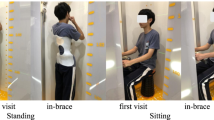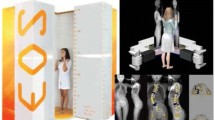Abstract
Purpose
To determine the short-term effect of bracing of adolescent idiopathic scoliotic (AIS) patients on the relationships between spinopelvic parameters related to balance, by comparing their in and out-of-brace geometry and versus healthy subjects.
Methods
Forty-two AIS patients (Cobb angle 29° ± 12°, ranging from 16° to 61°) with a prescription of orthotic treatment were included retrospectively and prospectively. They all underwent biplanar radiography and 3D reconstruction of the spine and pelvis before bracing as well as less than 9 months after bracing. Eighty-three age-matched healthy adolescents were also included as control group and underwent biplanar radiography and 3D reconstruction.
Results
Sacral slope was higher in AIS than healthy patients (p = 0.005). Bracing induced large changes of pelvic tilt (between − 9° and 9°), although patients’ sagittal spinopelvic alignment tended to remain within the normality corridors defined by the healthy patients. Patients had flatter backs compared to healthy subjects and bracing further reduced their spinal curves. The head tended to remain above the pelvis in-brace.
Conclusion
Analysis of sagittal alignment from head to pelvis showed that bracing further flattened the patients’ backs and induced large compensating reorientations of the pelvis. Sagittal balance should be included in the planning and evaluation of brace treatment, since it could play a role in its outcome.
Graphical abstract
These slides can be retrieved under Electronic Supplementary Material.









Similar content being viewed by others
References
Dubousset J (2018) Definition of adolescent idiopathic scoliosis—pathogenesis of idiopathic scoliosis. In: Weinstein SL, Dubousset J (eds) Machida M. Springer, Tokyo, pp 1–25
Le Huec JC, Gille O, Fabre T (2018) Sagittal balance and spine-pelvis relation: a French speciality? Orthop Traumatol Surg Res 104:551–554. https://doi.org/10.1016/j.otsr.2018.06.001
Barrey C, Roussouly P, Le Huec JC et al (2013) Compensatory mechanisms contributing to keep the sagittal balance of the spine. Eur Spine J 22:834–841. https://doi.org/10.1007/s00586-013-3030-z
Vedantam R, Lenke LG, Keeney JA, Bridwell KH (1998) Comparison of standing sagittal spinal alignment in asymptomatic adolescents and adults. Spine (Phila Pa 1976) 23:211–215
Le Huec JC, Hasegawa K (2016) Normative values for the spine shape parameters using 3D standing analysis from a database of 268 asymptomatic Caucasian and Japanese subjects. Eur Spine J 25:3630–3637. https://doi.org/10.1007/s00586-016-4485-5
Schwab F, Lafage V, Patel A, Farcy JP (2009) Sagittal plane considerations and the pelvis in the adult patient. Spine 34:1828–1833. https://doi.org/10.1097/BRS.0b013e3181a13c08
Legaye J, Duval-Beaupère G (2005) Sagittal plane alignment of the spine and gravity a radiological and clinical evaluation. Acta Orthop Belg 71:213–220. https://doi.org/10.1016/j.nec.2007.02.008
Vaz G, Roussouly P, Berthonnaud E, Dimnet J (2002) Sagittal morphology and equilibrium of pelvis and spine. Eur Spine J 11:80–87. https://doi.org/10.1007/s005860000224
Vialle R, Levassor N, Rillardon L et al (2005) Radiographic Analysis of the Sagittal Alignment and Balance of the Spine in Asymptomatic Subjects. J Bone Jt Surg 87:260–267. https://doi.org/10.2106/JBJS.D.02043
Lafage V, Schwab F, Vira S et al (2011) Spino-pelvic parameters after surgery can be predicted: a preliminary formula and validation of standing alignment. Spine (Phila Pa 1976) 36:1037–1045
Roussouly P, Labelle H, Rouissi J, Bodin A (2013) Pre- and post-operative sagittal balance in idiopathic scoliosis: a comparison over the ages of two cohorts of 132 adolescents and 52 adults. Eur Spine J 22:203–215. https://doi.org/10.1007/s00586-012-2571-x
Alzakri A, Vergar C, Van den Abbeele M, Gille O, Skalli W, Obeid I (2019) Global sagittal alignment and proximal junctional kyphosis in adolescent idiopathic scoliosis. Spine Deform 7(2):236–244. https://doi.org/10.1016/j.jspd.2018.06.014
Glassman SD, Bridwell K, Dimar JR et al (2005) The impact of positive sagittal balance in adult spinal deformity. Spine 30:2024–2029
Lazennec J-Y, Ramaré S, Arafati N et al (2000) Sagittal alignment in lumbosacral fusion: relations between radiological parameters and pain. Eur Spine J 9:47–55. https://doi.org/10.1007/s005860050008
Kumar M, Baklanov A, Chopin D (2001) Correlation between sagittal plane changes and adjacent segment degeneration following lumbar spine fusion. Eur Spine J 10:314–319. https://doi.org/10.1007/s005860000239
Dubousset J, Charpak G, Dorion I et al (2005) A new 2D and 3D imaging approach to musculoskeletal physiology and pathology with low-dose radiation and the standing position: the EOS system. Bull Acad Natl Med 189:287–300
Courvoisier A, Drevelle X, Vialle R et al (2013) 3D analysis of brace treatment in idiopathic scoliosis. Eur Spine J 22:2449–2455. https://doi.org/10.1007/s00586-013-2881-7
Lebel DE, Al-Aubaidi Z, Shin E-J et al (2013) Three dimensional analysis of brace biomechanical efficacy for patients with AIS. Eur Spine J 22:2445–2448. https://doi.org/10.1007/s00586-013-2921-3
Clin J, Aubin C-E, Parent S et al (2010) Comparison of the biomechanical 3D efficiency of different brace designs for the treatment of scoliosis using a finite element model. Eur Spine J 19:1169–1178. https://doi.org/10.1007/s00586-009-1268-2
Negrini S, Donzelli S, Aulisa AG et al (2018) 2016 SOSORT guidelines: orthopaedic and rehabilitation treatment of idiopathic scoliosis during growth. Scoliosis Spinal Disord 13:3. https://doi.org/10.1186/s13013-017-0145-8
Lonstein JE, Carlson JM (1984) The prediction of curve progression in untreated idiopathic scoliosis during growth. J Bone Jt Surg Am 66:1061–1071
Humbert L, De Guise JA, Aubert B et al (2009) 3D reconstruction of the spine from biplanar X-rays using parametric models based on transversal and longitudinal inferences. Med Eng Phys 31:681–687. https://doi.org/10.1016/j.medengphy.2009.01.003
Amabile C, Pillet H, Lafage V et al (2016) A new quasi-invariant parameter characterizing the postural alignment of young asymptomatic adults. Eur Spine J 25:3666–3674. https://doi.org/10.1007/s00586-016-4552-y
Coe D (2009) Fisher matrices and confidence ellipses: a quick-start guide and software. arXiv:09064123
Conover WJ, Iman RL (1982) Analysis of covariance using the rank transformation. Biometrics 38:715–724. https://doi.org/10.2307/2530051
Zaina F, Donzelli S, Lusini M, Negrini S (2012) Correlation between in-brace radiographic correction and short time brace results. Scoliosis 7:1. https://doi.org/10.1186/1748-7161-7-s1-o27
Clin J, Aubin C-É, Sangole A et al (2010) Correlation between immediate in-brace correction and biomechanical effectiveness of brace treatment in adolescent idiopathic scoliosis. Spine (Phila Pa 1976) 35:1706–1713. https://doi.org/10.1097/BRS.0b013e3181cb46f6
Vital JM, Senegas J (1986) Anatomical bases of the study of the constraints to which the cervical spine is subject in the sagittal plane a study of the center of gravity of the head. Surg Radiol Anat 8:169–173. https://doi.org/10.1007/BF02427845
Dubousset J (2011) Reflections of an orthopaedic surgeon on patient care and research into the condition of scoliosis. J Pediatr Orthop 31:S1–S8. https://doi.org/10.1097/BPO.0b013e3181f73beb
Amabile C, Le Huec J-C, Skalli W (2018) Invariance of head-pelvis alignment and compensatory mechanisms for asymptomatic adults older than 49 years. Eur Spine J 27:458–466. https://doi.org/10.1007/s00586-016-4830-8
Guo J, Liu Z, Lv F et al (2012) Pelvic tilt and trunk inclination: new predictive factors in curve progression during the Milwaukee bracing for adolescent idiopathic scoliosis. Eur Spine J 21:2050–2058. https://doi.org/10.1007/s00586-012-2409-6
Acknowledgements
The authors are grateful to the BiomecAM chair program on subject-specific musculoskeletal modelling (with the support of ParisTech and Yves Cotrel Foundations, Société Générale, Covea and Proteor) and to the DHU MAMUTH for funding. We are also grateful to Ms Fay Manning for her technical support.
Author information
Authors and Affiliations
Corresponding author
Ethics declarations
Conflict of interest
Wafa Skalli holds patents related to the EOS system and associated 3D reconstruction methods, with no personal financial benefit (royalties rewarded for research and education). Raphael Vialle received consulting fees from EOS Imaging unrelated to this study.
Additional information
Publisher's Note
Springer Nature remains neutral with regard to jurisdictional claims in published maps and institutional affiliations.
Electronic supplementary material
Below is the link to the electronic supplementary material.
Rights and permissions
About this article
Cite this article
Vergari, C., Courtois, I., Ebermeyer, E. et al. Head to pelvis alignment of adolescent idiopathic scoliosis patients both in and out of brace. Eur Spine J 28, 1286–1295 (2019). https://doi.org/10.1007/s00586-019-05981-8
Received:
Accepted:
Published:
Issue Date:
DOI: https://doi.org/10.1007/s00586-019-05981-8




